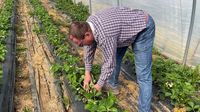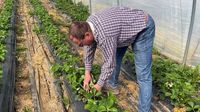The domestic asparagus cultivation faces significant challenges as rising labor costs, new legal regulations, and a decreasing availability of seasonal workers threaten the industry's viability. With the potential increase of the minimum wage to 15 euros per hour on the horizon, many farms are bracing for a tumultuous season ahead.
According to a 2023 agricultural census, around 243,000 seasonal workers were employed nationwide, accounting for 27% of all agricultural employees. Since the introduction of the minimum wage on January 1, 2015, wages for these workers have seen a substantial increase, rising from 8.50 euros to 12.82 euros per hour by the beginning of 2025.
During the recent federal election campaign, both the Green Party and the Social Democratic Party (SPD) advocated for a minimum wage increase to 15 euros, a figure also mentioned in the coalition agreement between the CDU and SPD. This impending wage hike could lead to a steep rise in labor costs, which already constitute between 30% and 60% of production expenses.
Since 2015, the cultivation area for strawberries has decreased by 24%, with outdoor cultivation plummeting by 42%. Alarmingly, one in four asparagus farms has ceased production in the same timeframe, according to the Asparagus and Berry Associations Network. The financial burden of labor costs, coupled with increasing bureaucratic demands, has deterred many in the next generation from taking over family farms.
In Lower Saxony, the statistics from the Federal Employment Agency reveal a significant shift in the demographics of seasonal workers. In 2015, there were approximately 5,650 Polish and 4,750 Romanian seasonal workers during the harvest months. Fast forward to 2023, and the numbers have drastically changed, with only 2,200 Polish workers and 5,100 Romanian workers reported. Currently, the hourly wage in Romania stands at 4.87 euros.
As farmers grapple with these challenges, they are raising alarms over the proposed minimum wage increase to 15 euros, which they believe could jeopardize their competitiveness and existence. They are calling for special regulations for short-term agricultural workers, emphasizing that their concerns are not about opposing the minimum wage itself but about ensuring the domestic harvest remains viable through targeted exceptions for seasonal workers.
However, the Industrial Union for Construction, Agriculture, and Environment (IG BAU) firmly opposes any special regulations for agriculture, insisting on fair wages for all workers.
The increasing production costs are putting pressure on domestic products, with fears that retailers may increasingly turn to cheaper imports. Experts are uncertain about the precise impact on pricing, but it is clear that the economic conditions for domestic production are becoming increasingly strained. A decline in fruit and vegetable production in Germany could lead to greater dependence on imports, with long-term implications for consumers.
Moreover, agricultural businesses are battling another pressing issue: a 2024 report by the Fair Agriculture Initiative highlighted deficiencies in the accommodation and payment of seasonal workers. Reports of exorbitant rents, inadequate sanitary facilities, and poorly insulated housing underscore the urgent need for reform.
In response to these challenges, the Lower Saxony Chamber of Agriculture (LWK) has proposed several initiatives to ease the burden on farmers, including new harvesting technologies and production methods. Examples include harvest aids for asparagus pickers and innovative cultivation techniques, such as growing strawberries on raised beds to facilitate easier picking.
However, these solutions tend to be capital-intensive and often only feasible for larger operations. Additionally, the use of full-harvesters for asparagus can lead to a reduction in the quality of the produce, potentially impacting profits.
In a bid to address the labor shortages, the Lower Saxony state government announced in March 2025 the establishment of a central skilled worker placement center. This initiative aims to streamline the recruitment of foreign workers across various sectors, including agriculture, by reducing bureaucratic hurdles and expediting work permits.
The challenges facing Lower Saxony's farmers reliant on seasonal labor are multifaceted: rising wages, dwindling availability of workers, increasing bureaucratic demands, and intensifying competition. To secure domestic production in the long term, targeted political measures are essential to provide practical solutions for farmers while ensuring fair working conditions for seasonal workers.
In the realm of strawberry cultivation, the season is set to commence soon, with the first fruits expected to be ready about four weeks earlier than those grown outdoors. Bio-farmer Marcus Fischer from Neuenstadt am Kocher anticipates that customers will pay approximately 10% to 15% more for strawberries this year compared to last year, although he cannot yet specify exact prices.
Andreas Frank, another organic farmer from Weinsberg-Gellmersbach, emphasizes the advantages of early harvesting, which not only enhances quality and flavor but also protects the strawberries from adverse weather conditions. His plants benefit from protective foil tunnels, shielding them from rain and the fungus Botrytis cinerea, which can damage the fruit.
Despite the challenges posed by rising labor costs, Frank remains optimistic about the upcoming season. He believes that consumers will find the prices of German strawberries affordable and is looking forward to the first harvest. He jokingly mentions that he is already hungry for strawberries!
As the strawberry season approaches, the Verband der Obst- und Gemüsewirtschaft in Baden-Württemberg has expressed a positive outlook, noting that winter cold and sufficient soil moisture provide excellent growth conditions. Last year saw average yields but significantly reduced revenues, yet the protected cultivation methods have had a favorable impact.
With the strawberry season just around the corner, farmers are preparing for what could be a challenging yet rewarding time, as they navigate rising costs and strive to deliver quality produce to consumers.






